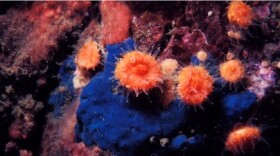Invasive green crabs are prolific all over the world. Officially called European green crabs, they are known for outcompeting native shellfish. On the East Coast of the U.S., they have been blamed for damaging shellfish harvests and decimating sea grass beds, which are critical habitat for juvenile salmon.
Now they’ve been discovered at Dungeness Spit near Sequim, on the Olympic Peninsula. It's alarming simply because of the location: a place famous for the iconic Northwest native crab. And the small population there seems to be spreading very quickly.
“We’re at 20 now,” said Allen Pleus from the Department of Fish & Wildlife. He’s the man in charge of fighting aquatic invasive species in Washington state. The new number went from 13 to 20 overnight after seven were found in the past week. It’s not a good sign for native species. But lots of parties are concerned.
“Luckily the U.S. Fish & Wildlife Service, who manages the Dungeness National Wildlife Refuge, has taken on the brunt of the trapping,” Pleus said. “We’ve loaned them whatever traps we had. And they have volunteers that have been assisting them to do the trapping.”
That’s a necessary scenario, he says, because his agency is also dealing with intensive monitoring of invasive zebra and quagga mussels right now. Spring is the season when all of these things begin reproducing quickly. But Pleus says fortunately there is concern, and not just from the state and national agencies.
Shellfish farmers and tribes are interested and concerned too. And there’s a virtual army of volunteers and citizen scientists to help.
Their marshal is Emily Grason. She’s with a group called Washington Sea Grant. They have been monitoring the green crab population for several years now.
“We’re definitely concerned and we’re glad that action is being taken swiftly. But this isn’t a time yet to throw up our hands and give up,” she said.
The crabs are euthanized after trapping, usually by freezing. Sea Grant’s early detection monitoring network now includes 36 sites.
People who want to help can visit their Crab Team website, where the advice for anyone who sees one is to leave it in place and take a photograph. Then email or upload it, so experts can evaluate it and take the right next steps.
Corrected on May 2, 2017 - A previous version of this story misspelled the name of Washington Sea Grant’s crab team program coordinator. Her name is Emily Grason.







